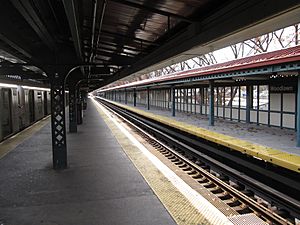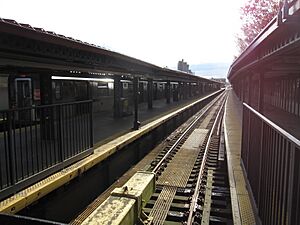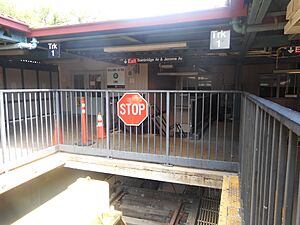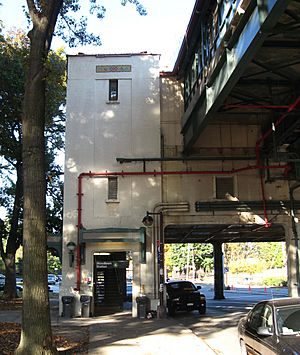Woodlawn station (IRT Jerome Avenue Line) facts for kids
Quick facts for kids
Woodlawn
|
|||||||
|---|---|---|---|---|---|---|---|

The platforms at Woodlawn, looking south
|
|||||||
| Station statistics | |||||||
| Address | Bainbridge Avenue & Jerome Avenue Bronx, NY 10467 |
||||||
| Borough | The Bronx | ||||||
| Locale | Norwood | ||||||
| Coordinates | 40°53′10″N 73°52′44″W / 40.886005°N 73.878808°W | ||||||
| Division | A (IRT) | ||||||
| Line | IRT Jerome Avenue Line | ||||||
| Services | 4 alltimes (all times) | ||||||
| Transit connections | |||||||
| Structure | Elevated | ||||||
| Platforms | 1 island platform (in service) 2 side platforms (unused) Spanish solution |
||||||
| Tracks | 2 | ||||||
| Other information | |||||||
| Opened | April 15, 1918 | ||||||
| Station code | 378 | ||||||
| Opposite-direction transfer available | N/A | ||||||
| Station succession | |||||||
| Next north | (Terminal): 4 alltimes | ||||||
| Next south | Mosholu Parkway (local): 4 alltimes Burnside Avenue (express): no regular service |
||||||
|
|||||||
|
|||||||
|
|||||||
|
Woodlawn Station (Dual System IRT)
|
|||||||
| MPS | New York City Subway System MPS | ||||||
| NRHP reference No. | 05000679 | ||||||
| Added to NRHP | July 6, 2005 | ||||||
The Woodlawn subway station is the very last stop on the New York City Subway's IRT Jerome Avenue Line. It is sometimes called Woodlawn-Jerome Avenue. You can find this station where Bainbridge and Jerome Avenues meet in The Bronx. It's right outside the famous Woodlawn Cemetery.
Even though it's called Woodlawn, the station is actually in the Norwood part of the Bronx. The 4 train serves this station all the time. The Interborough Rapid Transit Company (IRT) built this station, and it opened in 1918.
The station's opening helped the area around it grow, especially after Woodlawn Cemetery opened. After some updates in 2005, the station was added to the National Register of Historic Places. This was because of its special decorative concrete. A cool public art display made of stained glass called Children at Play was also added.
Contents
History of Woodlawn Station
How the Station Came to Be
In the 1840s, the first train connection to the Woodlawn area was made by the Harlem Railroad. This connection still exists today with the Woodlawn station on the Metro-North Railroad's Harlem Line. Back then, this part of the Bronx was mostly farms.
People started building homes after Woodlawn Cemetery opened in 1865. By the 1890s, many working-class Irish and Italian immigrants lived there. These residents really wanted a subway connection. The Interborough Rapid Transit Company (IRT) expanded its lines to meet this need.
Building the Subway Line
The "Dual Contracts" were agreements signed on March 19, 1913. These contracts planned for new subway lines in New York City. They were called "dual" because the city worked with two private companies: the Interborough Rapid Transit Company (IRT) and the Brooklyn Rapid Transit Company. Together, they made the new subway system possible.
As part of these contracts, the IRT agreed to build an elevated train line along Jerome Avenue in the Bronx.
When Woodlawn Station Opened
The first part of the Jerome Avenue Line opened on June 2, 1917. It was a shuttle service between Kingsbridge Road and 149th Street. Full service to the IRT Lexington Avenue Line began on July 17, 1918.
The Woodlawn station officially opened on April 15, 1918. It was part of the final section of the IRT Jerome Avenue Line, extending from Kingsbridge Road. The building of this line helped the areas along Jerome Avenue grow. It made them popular places for people who commuted to work.
The station got its name from Woodlawn Road, which was the old name for Bainbridge Avenue. However, it is most often linked to Woodlawn Cemetery. The main entrance to the cemetery is just a block away. After the station opened, the Woodlawn area became even more crowded. The cemetery also benefited, opening a sales office for burial plots. The subway made it easier for people from Harlem to visit. Many famous people from the Harlem Renaissance, like Duke Ellington, are buried at Woodlawn.
Recent Changes and Art
In the mid-2000s, the Woodlawn station was updated, along with other stations on the line. A second floor was added above the main entrance area. Inside, the newsstand was fixed up. After these updates, the station was added to the National Register of Historic Places.
A beautiful art piece called Children at Play was installed in two parts. The artist, Josie Gonzalez Albright, is known for her paintings and murals that show everyday people. This was her first time working with glass. She got ideas by watching her son and his friends play, and by exploring the area around the station.
How the Station is Designed
The Woodlawn station has two train tracks. It has one main island platform that people use. There are also two side platforms that are not used anymore. The tracks end at special "bumper blocks" at the north end of the platforms.
The station used to have a "Spanish solution" setup. This meant people getting off the train used the side platforms, and people getting on used the island platform. Now, everyone uses only the island platform. The 4 train stops here all the time.
The station is located above Jerome Avenue. It's just south of where Jerome Avenue meets Bainbridge Avenue. Woodlawn Cemetery is on the east side of the street. Its main entrance is a block north of the station. A large, wooded part of Van Cortlandt Park is on the other side.
Outside the Station
Squire J. Vickers, who was the main architect for the subway system, designed the station in 1917. He wanted elevated subway lines near important streets or parks to look nice with decorative concrete. This makes the Woodlawn station a special landmark in the area. Inside, it has the colorful ceramic tiles that you can see in many of his stations.
Woodlawn station is built with a steel frame covered in decorative concrete. It has a large main building at the north end.
Three big steel arches over Jerome Avenue hold up the main entrance level. The tracks above are supported by strong beams. These beams have special joints to help with the shaking from trains. A waterproof layer on top of the beams keeps the track floor dry.
The concrete on the platforms is smooth. Metal screens protect people from the wind along the side platforms. The west side has been partly closed off to create station rooms. The platforms have steel canopies with sloped roofs and fluorescent lights.
At the south end, the platforms are open with modern lampposts. There's an old signal tower with a pyramid roof just south of the island platform. Other service rooms are also located south of the platforms.
Inside the Station
You enter the station at the bottom of the stair towers. These entrances have a covered walkway.
Stairs lead up to the main entrance area, which has cream-colored brick walls. Here, you'll see fifteen stained glass panels in five windows. They show children playing with colorful backgrounds. This artwork is called Children at Play by Josie Gonzalez Albright. There is also a newsstand and restrooms here.
Three separate sets of stairs go up to the platform. On the platform level, there is an office for the train dispatcher and rooms for the train crew. You'll also find turnstiles and MetroCard machines to pay for your ride.
Station Exits
The only ways to exit the station are at the very north end of the platforms, where the main building is. There are two square concrete stair towers at each end of the building. These go down to either side of Jerome Avenue at Bainbridge Avenue. The windows on the west side are original, while those on the east have been covered. Murals with patriotic themes are painted on the sides. At the top, under the sloped roof, there's a colorful mosaic design.
Between the stair towers is a two-story section. The lower part is the main entrance area, made of concrete. It has three sections with large windows. Traffic lights are on the west side. Above this, there's what looks like a second story, set back slightly, with similar windows.
See also
In Spanish: Woodlawn (línea de la Avenida Jerome) para niños







